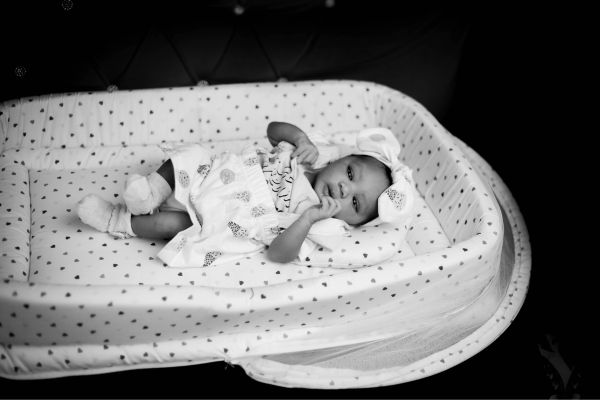So, you’re prepping for your little one’s arrival and the nursery checklist seems to be growing longer by the day. Diapers? Check. Onesies? Got ‘em. But when it comes to sleep—arguably the most important thing for both you and your baby—you hit the big question: bassinet vs crib?
It might seem like a small decision at first glance, but trust me, choosing between a bassinet and a crib can set the tone for those first few months (or even years) of sleep. And let’s be real, sleep is gold when you’re a new parent.
Let’s dive into this, shall we?
The Basics: What Even Is the Difference?
Alright, before we start throwing around preferences, let’s make sure we’re on the same page. A bassinet is that smaller, often portable sleeping space designed specifically for newborns. Think of it like a cozy little nest. Lightweight, easy to move, usually set up beside your bed—perfect for those middle-of-the-night feedings when your eyes barely open.
A crib, on the other hand, is bigger, sturdier, and meant for the long haul. It’s more of a permanent fixture in the nursery. Babies can sleep in a crib from day one and stay in it until they’re ready to transition to a toddler bed, usually around 2 to 3 years old.
Size Matters (Especially at 3 a.m.)
When it comes to bassinet vs crib, size plays a massive role. If you’re living in a cozy apartment or just trying to keep the baby close during the first few months, a bassinet makes total sense. It’s compact, fits snugly by your bedside, and some even come with wheels so you can roll your baby from room to room like royalty.
Cribs, however, are big. You need to have the space, both in your home and in your setup, to make them work. But they grow with your baby, which is a major plus.
Portability vs Stability
Let’s talk practicality for a sec.
Bassinets win the portability game hands-down. You can move them around, travel with them, and easily reach over to soothe your baby. Plus, some bassinets rock or vibrate, which can be a lifesaver during those colicky nights.
Cribs? Not so much. Once you set up a crib, it’s staying put. It’s like a piece of furniture—not something you casually scoot around the house. But what you trade in mobility, you gain in sturdiness. Cribs are solid. They’re built to last through the teething, pulling-up, jumping-around stages.
Safety First, Always
This is where things get a little serious. Sleep safety is non-negotiable.
The American Academy of Pediatrics (AAP) recommends room-sharing (not bed-sharing) for at least the first six months. This is why bassinets are so popular—they make that recommendation super doable.
But don’t assume bassinets are automatically safer just because they’re smaller. They have weight limits (usually around 15-20 pounds), and once your baby starts rolling or pushing up, it’s game over for bassinet days. You’ll need to transition to a crib for safety reasons.
Cribs, especially those that meet current safety standards, offer a safe sleeping space from day one. Just make sure you’re using a firm mattress, fitted sheet, and keeping it free of blankets, pillows, and toys. Boring, yes, but safe? Absolutely.
Longevity and Budget Talks
Alright, here’s where things get real. Budget.
If you’re trying to keep things minimal, you might ask yourself, “Why not skip the bassinet altogether?” That’s totally valid. A crib is a one-time investment that’ll last for years. Some even convert into toddler beds or daybeds, which gives you more bang for your buck.
A bassinet, however, is more of a short-term solution. Most babies outgrow them by the time they’re 3 to 6 months old. So while they’re often cheaper than cribs upfront, you’re still going to need a crib eventually. That means buying two sleep spaces instead of one.
But hey, if convenience, closeness, and those first few months of easier nighttime care matter more to you than long-term savings, a bassinet might still be worth it.
Middle-of-the-Night Feedings Hit Different
Let’s not gloss over the sleep-deprived haze of new parenthood. When your baby wakes every couple of hours, the idea of stumbling down the hall to a separate room can feel like climbing Everest in the dark.
A bassinet by your bed means less disruption. You reach over, soothe your baby, or scoop them up for a feed, all without leaving the comfort of your warm blanket. Cribs—especially if they’re in another room—require more effort. More steps. More waking up.
It’s a small detail, but one that makes a big difference when you’re running on fumes.
Style and Aesthetic (Because That Matters Too)
Hey, we all want our nursery (or bedroom corner) to look cute. It’s okay to admit that aesthetics matter, even when making practical decisions.
Bassinets often come in soft, cozy designs that feel sweet and gentle. Think linen fabrics, soft canopies, and natural wood finishes.
Cribs are more of a statement. They anchor the room. You’ll find everything from sleek modern designs to rustic farmhouse vibes. If you’re putting together a Pinterest-worthy nursery, the crib will likely be the centerpiece.
So… Bassinet vs Crib? Here’s the Real Talk
Honestly, there’s no universal answer. It all comes down to your lifestyle, space, and how you envision those first few months.
If you want to keep your newborn close, you’re tight on space, and you’re focused on ease during those early weeks, a bassinet might be your perfect match.
But if you’re all about long-term value, stability, and setting up a dedicated nursery from the get-go, then the crib could be the better move.
Some parents go the combo route—starting with a bassinet and transitioning to a crib once baby hits that 4-6 month mark. It’s not about picking the “right” choice universally. It’s about what’s right for you.
Final Thoughts
Bringing a baby home is a whirlwind. So many decisions, so many opinions flying at you from every direction. But when it comes to bassinet vs crib, trust yourself. Think about your space, your routines, your sleep (yes, yours too), and what’s going to help your family feel rested and secure.
Whichever you choose, just remember: it’s not permanent. You’ll adjust, adapt, and figure it out as you go. That’s the beauty of parenting. It’s messy, unpredictable, and somehow perfect in all its chaos.
Now go take a nap—you’re gonna need it.





